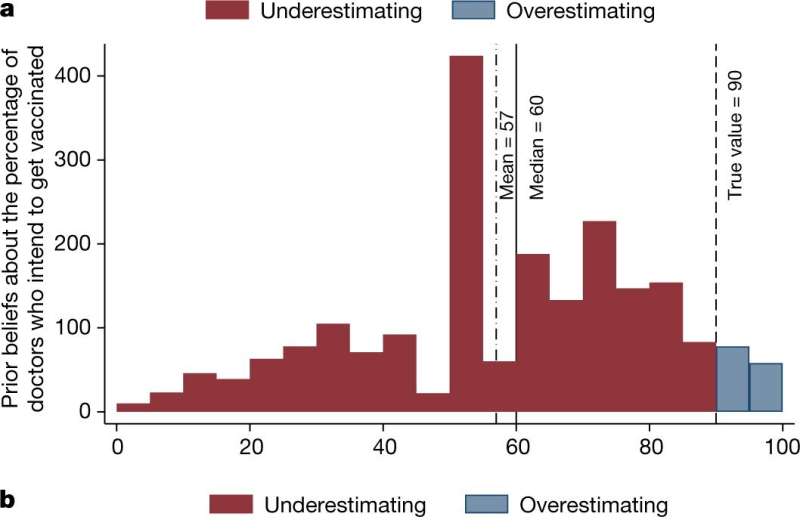
A new research study shows that public misperceptions about doctors’ views on COVID-19 vaccinations reduce willingness to get vaccinated. The study documents that the vast majority of medical doctors in the Czech Republic trust and support vaccination, but that there is a widespread belief among the public that doctors’ opinions are divided and that only about half trust the vaccines.
Informing people that there is a broad positive consensus among doctors persistently increases vaccination uptake by the public. Thus, effectively communicating doctors’ true views can play an important role in the fight against the COVID-19 pandemic. The study was published in the most recent issue of Nature. The authors of the study conducted extensive questionnaire surveys to identify the medical community’s views on vaccination against COVID-19, and then surveyed public perceptions of doctors’ views. Finally, they examined the effect of providing information about doctors’ actual views on individuals’ decisions to get vaccinated.
“We found that clearly communicating the strong consensus of the benefits of vaccination among doctors is a cheap way to persistently increase interest in vaccination,” says one of the study’s co-authors, Michal Bauer of CERGE-EI in Prague. The first survey took place in February 2021 among Czech doctors from all parts of the country. It focused on identifying doctors’ views of approved COVID-19 vaccines. Of the 10,000 doctors surveyed, a full 90% trusted the vaccines.
Furthermore, 90% had already been vaccinated themselves, or planned to be. As many as 95% of doctors stated that they would recommend vaccinations to their healthy patients. However, most of the Czech public was unaware of this consensus in the medical community. This was discovered thanks to the second survey, which took place as part of a Life During the Pandemic survey conducted in partnership with PAQ Research, 2 which involved 2,101 respondents. Respondents estimated what percentage of doctors trusted the vaccines and wanted to be vaccinated themselves. About 90% of the public sample underestimated the level of support for vaccination within the medical community. On average, people thought that only about 60% of doctors trusted the approved vaccines and that only around 57% of doctors wanted to be vaccinated themselves.
In March 2021, a randomly selected half of the respondents received correct information about the opinions of doctors about vaccination, i.e., that 90% trust the vaccines. The other half of the respondents did not receive this information. This allowed the researchers to reliably estimate the role that knowledge of the real views of the medical community plays in the willingness to be vaccinated. For the next nine months, the researchers monitored the respondents to see if they got vaccinated.
The information provided not only corrected misperceptions about doctors’ views on vaccination, but also increased vaccination uptake by 4.5 percentage points. The percentage of people who chose not to be vaccinated therefore fell by as much as 20%. “The effect on vaccination was stable and lasting. Even a one-time provision of information increased vaccination uptake for at least 9 months, and also increased demand for the third dose,” explains study co-author Julie Chytilová of Charles University in Prague.
The authors of the study believe that the documented public misperceptions about the views of the medical community are likely caused by a journalistic norm, to provide equal time and space to opposing views on controversial topics discussed in media. This practice attracts the attention of viewers and creates the appearance of an objective journalistic approach. However, it can distort perceptions in the society about the degree of dis/agreement among experts and undermine the ability to overcome societal challenges.
Source: Read Full Article


